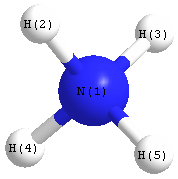Vibrational Frequencies calculated at B2PLYP/daug-cc-pVDZ
| Mode Number |
Symmetry |
Frequency
(cm-1) |
Scaled Frequency
(cm-1) |
IR Intensities
(km mol-1) |
Raman Act
(Å4/u) |
Dep P |
Dep U |
|---|
| 1 |
A1 |
3006 |
3006 |
0.00 |
87807.77 |
0.00 |
0.00 |
| 2 |
E |
1573 |
1573 |
0.00 |
7104.32 |
0.75 |
0.86 |
| 2 |
E |
1573 |
1573 |
0.00 |
7104.32 |
0.75 |
0.86 |
| 3 |
T2 |
3016 |
3016 |
710.16 |
12813.55 |
0.75 |
0.86 |
| 3 |
T2 |
3016 |
3016 |
710.16 |
12813.55 |
0.75 |
0.86 |
| 3 |
T2 |
3016 |
3016 |
710.16 |
12813.56 |
0.75 |
0.86 |
| 4 |
T2 |
1282 |
1282 |
151.60 |
4040.39 |
0.75 |
0.86 |
| 4 |
T2 |
1282 |
1282 |
151.60 |
4040.39 |
0.75 |
0.86 |
| 4 |
T2 |
1282 |
1282 |
151.60 |
4040.39 |
0.75 |
0.86 |
Unscaled Zero Point Vibrational Energy (zpe) 9522.1 cm
-1
Scaled (by 1) Zero Point Vibrational Energy (zpe) 9522.1 cm
-1
See section
III.C.1 List or set vibrational scaling factors
to change the scale factors used here.
See section
III.C.2
Calculate a vibrational scaling factor for a given set of molecules
to determine the least squares best scaling factor.
Charges, Dipole, Quadrupole and Polarizability
Charges from optimized geometry at B2PLYP/daug-cc-pVDZ
Charges (e)
| Number |
Element |
Mulliken |
CHELPG |
AIM |
ESP |
| 1 |
N |
0.111 |
|
|
|
| 2 |
H |
-0.028 |
|
|
|
| 3 |
H |
-0.028 |
|
|
|
| 4 |
H |
-0.028 |
|
|
|
| 5 |
H |
-0.028 |
|
|
|
Electric dipole moments
Electric dipole components in Debye
(What's a Debye? See section
VII.A.3)
| |
x |
y |
z |
Total |
| |
0.000 |
0.000 |
0.000 |
0.000 |
| CHELPG |
|
|
|
|
| AIM |
|
|
|
|
| ESP |
|
|
|
|
Electric Quadrupole moment
Quadrupole components in D Å
| Primitive |
|---|
| | x | y | z |
|---|
| x |
-15.944 |
-0.032 |
0.000 |
| y |
-0.032 |
-15.944 |
0.000 |
| z |
0.000 |
0.000 |
-15.952 |
|
| Traceless |
|---|
| | x | y | z |
|---|
| x |
0.004 |
-0.032 |
0.000 |
| y |
-0.032 |
0.004 |
0.000 |
| z |
0.000 |
0.000 |
-0.008 |
|
| Polar |
|---|
| 3z2-r2 | -0.016 |
|---|
| x2-y2 | 0.000 |
|---|
| xy | -0.032 |
|---|
| xz | 0.000 |
|---|
| yz | 0.000 |
|---|
|
Polarizabilities
Components of the polarizability tensor.
Units are
Å
3 (Angstrom cubed)
Change units.
| |
x |
y |
z |
| x |
31.448 |
0.130 |
0.000 |
| y |
0.130 |
31.448 |
0.000 |
| z |
0.000 |
0.000 |
31.454 |
<r2> (average value of r
2) Å
2
| <r2> |
14.325 |
| (<r2>)1/2 |
3.785 |
